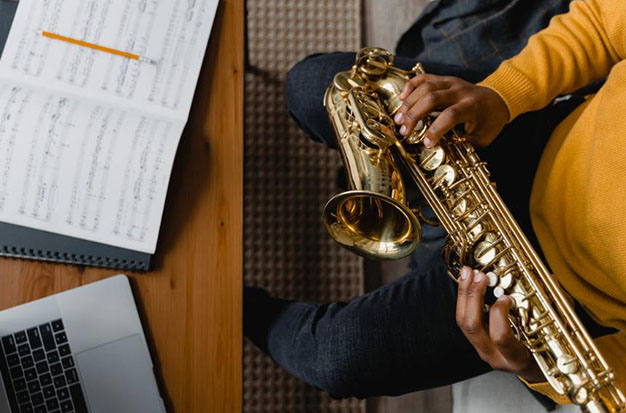Are you wondering how long it takes to learn to play the saxophone? Can you really learn the saxophone on your own?
In this article, we’ll provide you with answers to these and a lot more questions. If you’re intrigued by that, then let’s start talking about it.
Table of Contents
How Long Does It Take To Learn The Saxophone?
Think about what you’re willing to do before you respond to that question.” You are obviously a highly motivated individual who is willing to learn the saxophone and a naturally curious learner.
Even the most tenacious person can struggle with it, so you really need to be honest with yourself by being realistic about the time and effort you will put into learning the sax. Set high standards for yourself because if you don’t, you’ll be disappointed in your progress.
Like the great Charlie Parker, who once claimed he practiced 12 to 15 hours per day in an interview, you won’t, for instance, practice that much. Don’t keep yourself up at night wondering how long it would actually take to learn it; you won’t learn it in one sitting either.
I advise beginners to practice for at least 30 minutes per day, five days a week. The more you practice, the more comfortable you will become playing, but it is crucial to stay consistent.
Is The Saxophone Hard To Learn?
On the first day, playing the saxophone, getting a sound should be simple. If the sound doesn’t respond, excessive jaw pressure is probably compressing the mouthpiece and reed together.
The way you hold your lips on the mouthpiece of the saxophone is called the “embouchure.” This is the most important skill to learn on the saxophone, and it greatly affects tone quality. Years of practice are needed to develop this skill, which takes time.
So, to really answer your question, “Is it difficult to learn the saxophone?” … The fact is that some people will find learning the saxophone to be easier than others. However, practice is a must for everyone! Due to their smaller hands and mouths, students under the age of middle school would find it very challenging to learn the saxophone.
On the other hand, people who have prior experience with any wind instrument, especially woodwinds like the clarinet, will adapt to the saxophone more quickly. The saxophone’s fingering system is fortunately simpler than that of other woodwind instruments.
The saxophone’s inability to provide instant gratification is one of its biggest difficulties. Achieving a good tone quality, it takes a lot of time and effort.
Which Instrument Is Simpler To Play, The Trumpet Or The Saxophone?
The trumpet and violin are known for being the most challenging instruments to play at a high level.
In general, that is accurate.
You need to practice your trumpet for at least three hours every day in order to maintain your tone—really, in order to progress with it.
Otherwise, there’s no point in starting.
The saxophone, on the other hand, is a one-note instrument, so it’s not as hard as the trumpet to keep your tone. After a year or two of daily practice, you will be able to produce a tone that is consistently good.
A good tone can be interpreted as having a mature demeanor. something that is enjoyable to hear.
That’s means before that year or so, it’s probably ill-advised to play a lot publicly, because the sound is just not nice enough yet for most people to enjoy listening to.
Most professional musicians agree that the violin and trumpet are the two instruments that are the most difficult to play. Again, though, it depends on who you ask.
Saxophone Vs. Piano Difficulty
The maturity of tone really makes a big difference when you contrast it with something like a piano for instance. A piano can be seen as having its own, recurring music.
No matter who hits the keys, the notes are flawless.
On the other end of the spectrum in this case is the saxophone. The sound is actually being made by you. As a result, if you can’t do it or don’t have a well-developed technique for doing it, the results won’t be the same.
And, people love the sound of the saxophone.
If I go solely by the number of people who look me up after a show and tell me how much they love the sound of a saxophone or simply say it’s one of their favorite instruments, it’s a lot.
The kind of thing you probably notice right away when playing the saxophone is the appreciation of sound, I suppose.
That makes the saxophone one of those instruments (along with the trumpet or violin), where it takes a lot of time and effort to get anywhere in the beginning.
But once you get going, it’s so much fun to figure things out as you go.
The saxophone is a one-note instrument, which is obvious when studying music.
On a piano, you can play many keys at the same time, where you have a left hand and the right hand where you have a bass part and a melody part, you are doing two things at the same time, right from the get-go.
In that sense, the saxophone is a melody instrument. In terms of things like progressions and baselines, you don’t really care about harmony at all.
The saxophone is primarily used for solos and melodies. Right there, that takes away a little bit of the challenge, but harmony knowledge is still necessary for good playing.
On the saxophone, you simply don’t need to practice harmony as much as you would on a piano or guitar. Therefore, the saxophone is a little simpler in that regard.
Saxophone Is Harder Than Guitar, Isn’t It?
It really does take quite a bit of effort to do anything with the saxophone that an audience can even start to appreciate
Whereas with a guitar or piano, you can learn some chords and within a day you are playing your song and it’s really nice to listen to, or you can just play some chords and it’s already nice music.
But as with anything, there are some guitarists whose playing is extremely challenging to emulate, even with a lot of practice.
All instruments are therefore equally difficult on a professional level.

What Specific Technical Knowledge Is Necessary For Saxophone Playing?
To play the saxophone, you must master a variety of skills. Having a good embouchure, being familiar with all of the fingerings, understanding basic music theory, voicing for the saxophone (the process of what happens inside your mouth and body that affects your saxophone playing), setting up the instrument, having a mouthpiece set up that is just right, basic time management, articulation, general musical knowledge, goal setting, and, of course, a passion for saxophone playing are some of these skills.
I share this information with you in order to help you approach playing the instrument methodically. If you follow a structured approach to learning the saxophone, you may save some time and, regardless, you will get better at playing the instrument. See more about How Hard Is It To Learn To Play The Harmonica?
How Much Practice Time Should I Set Aside To Achieve My Objective?
The most simplistic and patronizing response to this question is, “The more you practice, the quicker you’ll get there,” but because you don’t want to sound like a complete d*ck, here are some general guidelines:
You don’t want to pursue music as a career; instead, you just want to be able to play some of your favorite songs and maybe join your coworkers in the office big band (which should totally be a thing). However, you don’t have a lot of free time, and Netflix won’t binge-watch for you, so what do you do?
Okay, start with just 20 minutes per day, and you should notice some improvement within the first year. Then, you might consider going for longer practice sessions to really dive in, but don’t beat yourself up if you miss a few days here and there. If you could average an hour every other day for 2 to 4 years with consistent guidance from a good teacher, you should hit your target. See more about How Long Does It Take To Learn The Ukulele?
Trying To Learn The Saxophone On Your Own?
Saxophones are the most straightforward to learn on your own out of all the available wind instruments. Although this might be the case, learning to play the saxophone on your own can be very challenging. This is due to the fact that, without any personal instruction, you might find it difficult to immediately understand certain saxophone playing habits and techniques.
Some of the few things you must learn to play the saxophone are tone articulation, proper fingering, and tone production. Unfortunately, without the right instruction, you run the risk of developing bad learning habits in these areas. This will have an impact on the quality of the sound you create while playing.
Therefore, what I’d advise is that you hire a tutor to help you out in the beginning of your saxophone journey. You will have a strong base to build on if you do this. It is simpler to teach yourself to play the saxophone perfectly after gaining a solid understanding of the fundamentals from a local tutor. See more about How To Learn To Play Mandolin For Beginners?
How Long Will It Take Me To Learn The Saxophone On My Own?
Self-learning the saxophone typically takes 2-4 years. Depending on how frequently you practice and how dedicated you are to learning the instrument, learning to play the saxophone will take some time.
The saxophone can typically be learned in two to four years with sufficient practice and commitment. Individuals who study the saxophone on their own, however, do not advance as quickly as those who hire qualified in-person tutors.
Additionally, people who have played clarinets or other wind instruments before are more likely to pick up the saxophone quickly.
Factors That Affect Your Ability To Learn Saxophones Quickly
Experience
You might find it somewhat more challenging to play the saxophone than someone who has experience with other woodwind instruments if this is your first time picking up a saxophone. This is due to the fact that playing other wind or woodwind instruments, particularly the clarinet, can help you learn the saxophone more quickly.
Saxophones are usually easy for people who have played other woodwind instruments before to pick up. Can saxophone players play the clarinet? is the title of a previous article I wrote.” sheds more light on this. This means that you have a learning advantage over someone who has never played any wind instrument if you are able to play other similar wind instruments.
Concepts like embouchure, breath support, volume control, and fingering may seem foreign to someone who is completely new to playing woodwind instruments. As a result, it might be somewhat more difficult for such a person to fully understand these concepts quickly.
Practice Time And Effort
Playing a musical instrument requires practice. Regular practice is necessary if you want to become a better saxophonist. Playing the saxophone requires daily commitment. It is actually preferable to practice your saxophone for 5 to 10 minutes every day rather than for an hour once a week.
The number of saxophone tutorials, videos, and lessons you watch or read won’t help you much if you don’t put in enough practice. As a result, consistent practice is essential to learning the saxophone.

How Can I Teach Myself Saxophone?
Almost all musical instruments can be learned to play by yourself. Similarly, saxophones. However, in order to do so, you would require some assistance and materials to support your search.
In the near future, I’ll discuss the tools you can use to learn the saxophone. The good news is that the majority of these resources are available online. These tools have one benefit over in-person saxophone tutors: you can access them whenever you’re ready to learn. They are therefore convenient and available whenever you need them.
Beginner Saxophone Method Books
This kind of book explains the necessary skills required to play the instrument. The majority of these beginner method books also offer detailed instructions and in-depth information on technique-related issues and how to deal with them.
Most saxophone method books also include easy popular songs and instructions on how to play them. A lesson plan is also given to you, which you should use. Therefore, investing in a good saxophone beginner method book will be extremely beneficial when learning to play the instrument on your own.
Video Tutorials
There are numerous video tutorials and guides available that can help you learn about any subject or field you are interested in. All you have to do is diligently look for them.
YouTube is among the ideal starting points. Saxophone learning videos can be found in abundance on YouTube. The majority of these videos will give you all the knowledge you require to start learning to play the saxophone.
Sadly, some of these videos aren’t all that good either. As a result, you might need to take some time to separate the good channels and videos from the bad ones. And this is the benefit that courses have over unrestricted YouTube.
Despite this, once you choose a fantastic saxophone lessons channel, it will be worthwhile.
Online Courses
One of the best ways to learn the instrument is without a doubt through online saxophone lessons. If you’re serious about learning how to play the sax, I actually strongly advise buying or enrolling in an online saxophone course.
Why do I say this?
First off, saxophone classes are thoughtfully organized and planned. Beginners can easily follow along step by step because of this.
Second, it is the closest thing to a personal tutor you can find. Expert saxophonists who are also seasoned in-person tutors frequently create saxophone video courses. This means they are aware of every query new students have, and they make sure to cover them in their courses.
And if you enroll in a saxophone course that is subscription-based, tutors regularly add new material to their courses to address some of the most frequently asked questions by students. And this keeps the content helpful and up to date
Smartphone Apps
You can learn to play the saxophone with the aid of some excellent smartphone applications. They offer a vast array of useful information on learning the saxophone and are perfect for saxophone practice. The majority of smartphone saxophone learning apps provide tutorials that are helpful for instructing beginners. They hone saxophone players’ abilities in this way.
They can also be used by saxophonists who are intermediate or advanced to refresh their memories. In-depth details on saxophone fingering charts are also provided by some of these apps. So, when learning to play the saxophone, smartphone apps that teach you about saxophones can be very helpful to you.
Conclusion
I’m hoping you have fun playing the saxophone.
Learning to play more quickly is facilitated by regular practice, knowledge of what to practice, effective time management, and the growth of a steady musical repertoire. “Rome wasn’t built in a day, and your amazing saxophone skills won’t appear in less than an hour either.



